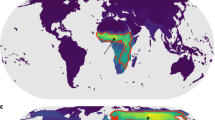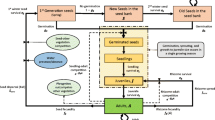Abstract
Invasive species represent one of the greatest risks to global biodiversity and economic productivity of agroecosystems. The development of certain novel crops—e.g., herbaceous perennial biomass crops—may create a risk of novel invasions by these crops. Therefore, potential benefits and risks need to be weighed in making decisions about their introduction and subsequent management. Ideally, such a weighing will be based on good estimates of invasion risks in realistic scenarios pertaining to actual landscapes of concern. Most previous large-scale analyses of invasion risk have used species distribution models and their established methods. Unfortunately, these approaches are unable to incorporate local scale biotic and spatial factors that influence invasion risk. Here we present a case study for how such factors can be efficiently incorporated in large-scale analyses of invasion risk, by extending simulation models with statistical modeling tools. By these means, we predict invasion risk at the scale of the entire United States for a major biomass crop, Miscanthus × giganteus. We then combine invasion risk predictions for this method with those from bioclimatic methods, producing a map of aggregated invasion risk that can offer more nuanced predictions of invasion risk than either approach alone. Lastly, we evaluate potential risks for invasive crops that differ in invasiveness traits, to examine how geographic patterns of invasion risk vary among invaders as a result of their particular constellation of traits.





Similar content being viewed by others
References
Barney JN, DiTomaso JM (2011) Global climate niche estimates for bioenergy crops and invasive species of agronomic origin: potential problems and opportunities. PLoS One 6:e17222
Barros C, Palmer SCF, Bocedi G, Travis JMJ (2016) Spread rates on fragmented landscapes: the interacting roles of demography, dispersal and habitat availability. Divers Distrib 22:1266–1275. https://doi.org/10.1111/ddi.12487
Bradley BA, Mustard JF (2006) Characterizing the landscape dynamics of an invasive plant and risk of invasion using remote sensing. Ecol Appl 16:1132–1147. https://doi.org/10.1890/1051-0761(2006)016%5b1132:CTLDOA%5d2.0.CO;2
Cardille J, Turner M, Clayton M et al (2005) Metaland: characterizing spatial patterns and statistical context of landscape metrics. Bioscience 55:983–988. https://doi.org/10.1641/0006-3568(2005)55%5b0983:MCSPAS%5d2.0.CO;2
Chase JM, Leibold MA (2003) Ecological niches: linking classical and contemporary approaches. University of Chicago Press, Chicago
Chen H-G, Zhang Y-HP (2015) New biorefineries and sustainable agriculture: increased food, biofuels, and ecosystem security. Renew Sustain Energy Rev 47:117–132. https://doi.org/10.1016/j.rser.2015.02.048
Crespo-Pérez V, Rebaudo F, Silvain J-F, Dangles O (2011) Modeling invasive species spread in complex landscapes: the case of potato moth in Ecuador. Landsc Ecol 26:1447–1461. https://doi.org/10.1007/s10980-011-9649-4
Davis MA (2003) Biotic globalization: does competition from introduced species threaten biodiversity? Bioscience 53:481–489. https://doi.org/10.1641/0006-3568(2003)053%5b0481:BGDCFI%5d2.0.CO;2
de Fraiture C, Giordano M, Liao Y (2008) Biofuels and implications for agricultural water use: blue impacts of green energy. Water Policy 10:67–81
Deckers B, Verheyen K, Hermy M, Muys B (2005) Effects of landscape structure on the invasive spread of black cherry Prunus serotina in an agricultural landscape in Flanders, Belgium. Ecography (Cop) 28:99–109. https://doi.org/10.1111/j.0906-7590.2005.04054.x
Dougherty RF, Quinn LD, Endres AB et al (2014) Natural history survey of the ornamental grass miscanthus sinensis in the introduced range. Invasive Plant Sci Manag 7:113–120. https://doi.org/10.1614/IPSM-D-13-00037.1
Elith J, Leathwick JR (2009) Species distribution models: ecological explanation and prediction across space and time. Ann Rev Ecol Evol Syst 40:677–697. https://doi.org/10.1146/annurev.ecolsys.110308.120159
Epanchin-Niell RS, Wilen JE (2012) Optimal spatial control of biological invasions. J Environ Econ Manag 63:260–270. https://doi.org/10.1016/j.jeem.2011.10.003
Fitzpatrick MC, Hargrove WW (2009) The projection of species distribution models and the problem of non-analog climate. Biodivers Conserv 18:2255. https://doi.org/10.1007/s10531-009-9584-8
Franklin J (2010) Moving beyond static species distribution models in support of conservation biogeography. Divers Distrib 16:321–330. https://doi.org/10.1111/j.1472-4642.2010.00641.x
Fry J, Xian GZ, Jin S et al (2011) Completion of the 2006 national land cover database for the conterminous united states. Photogramm Eng Remote Sens 77:858–864
Gallien L, Münkemüller T, Albert CH et al (2010) Predicting potential distributions of invasive species: where to go from here? Divers Distrib 16:331–342. https://doi.org/10.1111/j.1472-4642.2010.00652.x
Guisan A, Thuiller W (2005) Predicting species distribution: offering more than simple habitat models. Ecol Lett 8:993–1009
Havlík P, Schneider UA, Schmid E et al (2011) Global land-use implications of first and second generation biofuel targets. Energy Policy 39:5690–5702. https://doi.org/10.1016/j.enpol.2010.03.030
Heaton EA, Dohleman FG, Miguez AF, et al (2010) Miscanthus: a promising biomass crop. In: Research J-CK, in Botanical MDBT-A (eds). Academic Press, New York, pp 75–137
Higgins SI, Richardson DM, Cowling RM (1996) Modeling invasive plant spread: the role of plant-environment interactions and model structure. Ecology 77:2043–2054. https://doi.org/10.2307/2265699
Hirzel AH, Le Lay G (2008) Habitat suitability modelling and niche theory. J Appl Ecol 45:1372–1381. https://doi.org/10.1111/j.1365-2664.2008.01524.x
Hooten MB, Hobbs NT (2014) A guide to Bayesian model selection for ecologists. Ecol Monogr 85:3–28. https://doi.org/10.1890/14-0661.1
Jordan NR, Dorn K, Runck B et al (2016) Sustainable commercialization of new crops for the agricultural bioeconomy. Elem Sci Anthr 4:1–10. https://doi.org/10.12952/journal.elementa.000081
Kissling WD, Dormann CF, Groeneveld J et al (2012) Towards novel approaches to modelling biotic interactions in multispecies assemblages at large spatial extents. J Biogeogr 39:2163–2178. https://doi.org/10.1111/j.1365-2699.2011.02663.x
Kriticos DJ, Sutherst RW, Brown JR et al (2003) Climate change and biotic invasions: a case history of a tropical woody vine. Biol Invasions 5:147–165. https://doi.org/10.1023/A:1026193424587
Leung B, Roura-Pascual N, Bacher S et al (2012) TEASIng apart alien species risk assessments: a framework for best practices. Ecol Lett 15:1475–1493. https://doi.org/10.1111/ele.12003
Maron JL, Vilà M (2001) When do herbivores affect plant invasion? Evidence for the natural enemies and biotic resistance hypotheses. Oikos 95:361–373. https://doi.org/10.1034/j.1600-0706.2001.950301.x
McGarigal K, Cushman SA, Ene E (2012) FRAGSTATS v4: spatial pattern analysis program for categorical and continuous maps
Merow C, LaFleur N, Silander JA Jr et al (2011) Developing dynamic mechanistic species distribution models: predicting bird-mediated spread of invasive plants across Northeastern North America. Am Nat 178:30–43. https://doi.org/10.1086/660295
Mishra U, Torn MS, Fingerman K (2013) Miscanthus biomass productivity within US croplands and its potential impact on soil organic carbon. GCB Bioenergy 5:391–399. https://doi.org/10.1111/j.1757-1707.2012.01201.x
Muthukrishnan R, West NM, Davis AS et al (2015) Evaluating the role of landscape in the spread of invasive species: the case of the biomass crop Miscanthus × giganteus. Ecol Modell 317:6–15. https://doi.org/10.1016/j.ecolmodel.2015.08.022
Muthukrishnan R, Davis AS, Jordan NR, Forester JD (2018a) Invasion complexity at large spatial scales is an emergent property of interactions among landscape characteristics and invader traits. PLoS One 13:e0195892. https://doi.org/10.1371/journal.pone.0195892
Muthukrishnan R, Davis AS, Jordan NR, Forester JD (2018b) Data from: use of simulation-based statistical models to complement bioclimatic models in predicting continental scale invasion risks. Dryad Digital Repos. https://doi.org/10.5061/dryad.ms768r4
Nehrbass N, Winkler E, Müllerová J et al (2007) A simulation model of plant invasion: long-distance dispersal determines the pattern of spread. Biol Invasions 9:383–395. https://doi.org/10.1007/s10530-006-9040-6
Pearson RG, Dawson TP (2005) Long-distance plant dispersal and habitat fragmentation: identifying conservation targets for spatial landscape planning under climate change. Biol Conserv 123:389–401. https://doi.org/10.1016/j.biocon.2004.12.006
Pimentel D, Lach L, Zuniga R, Morrison D (2000) Environmental and economic costs of nonindigenous species in the United States. Bioscience 50:53–65
Pimentel D, Zuniga R, Morrison D (2005) Update on the environmental and economic costs associated with alien-invasive species in the United States. Ecol Econ 52:273–288. https://doi.org/10.1016/j.ecolecon.2004.10.002
Pittman S, Muthukrishnan R, West N et al (2015) Mitigating the potential for invasive spread of the exotic biofuel crop, Miscanthus × giganteus. Biol Invasions 17:3247–3261. https://doi.org/10.1007/s10530-015-0950-z
Quinn LD, Allen DJ, Stewart JR (2010) Invasiveness potential of Miscanthus sinensis: implications for bioenergy production in the United States. Glob Change Biol Bioenergy 2:310–320
Quinn LD, Matlaga DP, Stewart JR, Davis AS (2011) Empirical evidence of long-distance dispersal in Miscanthus sinensis and Miscanthus × giganteus. Invasive Plant Sci Manag 4:142–150. https://doi.org/10.1614/IPSM-D-10-00067.1
Raghu S, Anderson RC, Daehler CC et al (2006) Adding biofuels to the invasive species fire? Science 80(313):1742
Rejmanek M, Richardson DM (1996) What attributes make some plant species more invasive? Ecology 77:1655–1661. https://doi.org/10.2307/2265768
Rouget M, Richardson DM (2003) Inferring process from pattern in plant invasions: a semimechanistic model incorporating propagule pressure and environmental factors. Am Nat 162:713–724. https://doi.org/10.1086/379204
Rouget M, Richardson DM, Nel JL et al (2004) Mapping the potential ranges of major plant invaders in South Africa, Lesotho and Swaziland using climatic suitability. Divers Distrib 10:475–484. https://doi.org/10.1111/j.1366-9516.2004.00118.x
Schulte LA, Niemi J, Helmers MJ et al (2017) Prairie strips improve biodiversity and the delivery of multiple ecosystem services from corn–soybean croplands. Proc Natl Acad Sci 114:11247–11252
Simberloff D (2005) The politics of assessing risk for biological invasions: the USA as a case study. Trends Ecol Evol 20:216–222. https://doi.org/10.1016/j.tree.2005.02.008
Sutherst RW, Maywald GF (1985) A computerised system for matching climates in ecology. Agric Ecosyst Environ 13:281–299. https://doi.org/10.1016/0167-8809(85)90016-7
Theoharides KA, Dukes JS (2007) Plant invasion across space and time: factors affecting nonindigenous species success during four stages of invasion. New Phytol 176:256–273. https://doi.org/10.1111/j.1469-8137.2007.02207.x
Thuiller W, Richardson DM, Pyšek P et al (2005) Niche-based modelling as a tool for predicting the risk of alien plant invasions at a global scale. Glob Change Biol 11:2234–2250. https://doi.org/10.1111/j.1365-2486.2005.001018.x
Thuiller W, Richardson DM, Rouget M et al (2006) Interactions between environment, species traits, and human uses describe patterns of plant invasions. Ecology 87:1755–1769. https://doi.org/10.1890/0012-9658(2006)87%5b1755:IBESTA%5d2.0.CO;2
Williamson M (2006) Explaining and predicting the success of invading species at different stages of invasion. Biol Invasions 8:1561–1568. https://doi.org/10.1007/s10530-005-5849-7
Acknowledgements
This work was funded by USDA-NIFA Grant #2012-67013 to NRJ, ASD and JDF. We are grateful for computational resources from the University of Minnesota Supercomputing Institute. We thank Rob Venette and Umakant Mishra for assistance with the bioclimatic modeling.
Author information
Authors and Affiliations
Corresponding author
Data availability
Data availability
All data and models scripts are archived in the Dryad Data Repository. https://doi.org/10.5061/dryad.ms768r4.
Rights and permissions
About this article
Cite this article
Muthukrishnan, R., Jordan, N.R., Davis, A.S. et al. Use of simulation-based statistical models to complement bioclimatic models in predicting continental scale invasion risks. Biol Invasions 21, 847–859 (2019). https://doi.org/10.1007/s10530-018-1864-3
Received:
Accepted:
Published:
Issue Date:
DOI: https://doi.org/10.1007/s10530-018-1864-3




